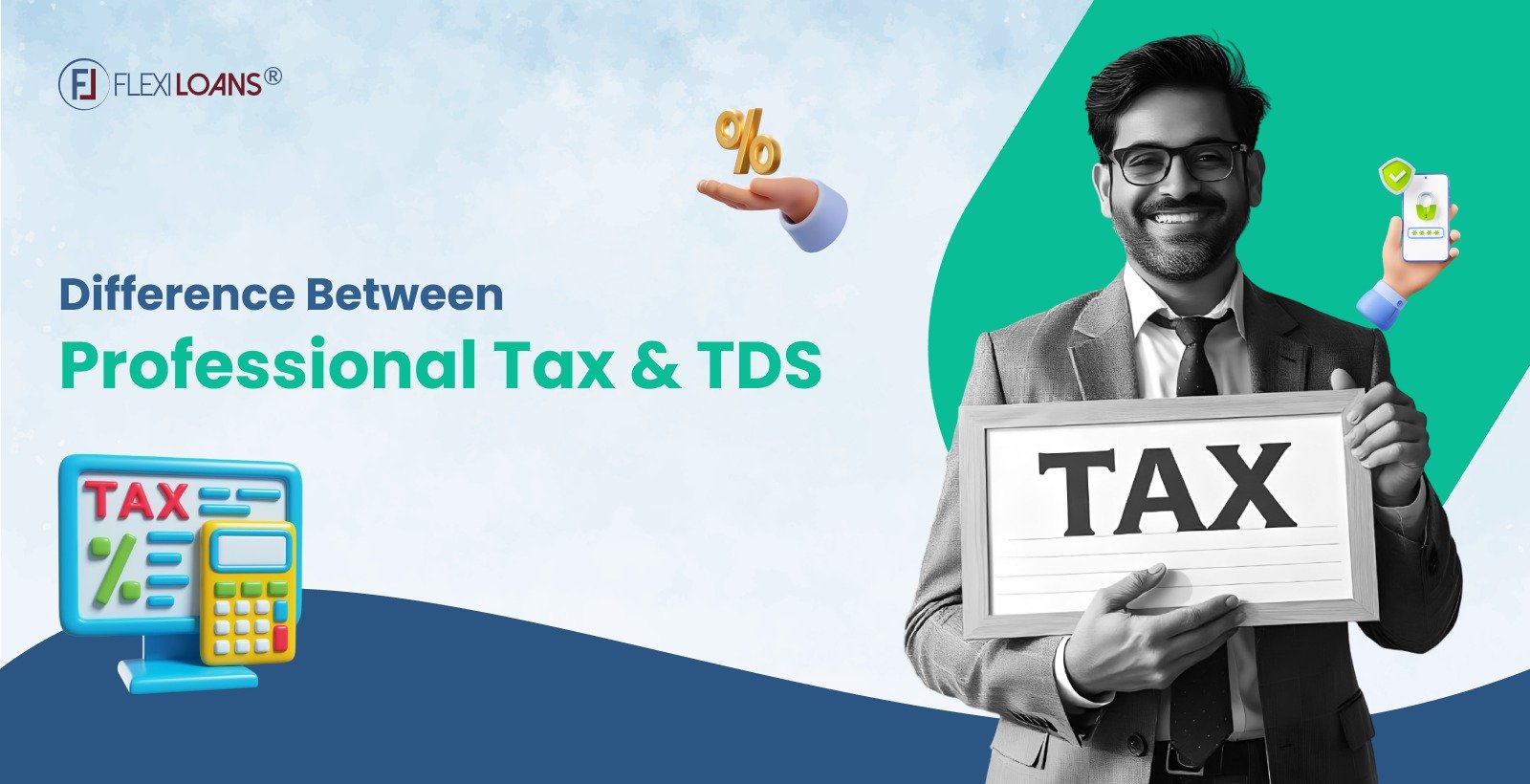Nov 12, 2024
Sep 29, 2025

Understanding professional tax (PT) is crucial for SMEs for several reasons. It ensures compliance with local tax laws, impacts payroll management, and supports proper financial planning and tax filing. This article will explore professional tax, how it differs from TDS, and the consequences of non-compliance.
What is Professional Tax?
Professional tax is a state-level tax on various forms of income. It applies to earnings from employment, business, freelancing, and trades. The tax is deductible when calculating income tax and varies from one state to another. The respective state governments utilise the collected revenue for development activities.
Professional Tax In India
Article 276 of the Constitution of India mandates professional tax. This tax applies to salaried employees, self-employed individuals, professionals such as lawyers, doctors, and chartered accountants, as well as businesses and traders. The Constitution permits states to collect a maximum of ₹2,500 per year in professional tax.
As of 2024, about 21 states and 1 union territory levy professional tax. Notable states include Maharashtra, Gujarat, Karnataka, West Bengal, Tamil Nadu, and Telangana.
Difference between Professional Tax and TDS
| Aspect | Professional Tax | TDS (Tax Deducted at Source) |
|---|---|---|
| Definition | A state-level tax levied on individuals earning income from employment or practicing a profession | A technique for gathering income tax directly from the earnings source |
| Jurisdiction | State-specific (not all states impose it) | Nationwide (implemented by the central government) |
| Collecting Authority | State government | Central government |
| Applicability | Employed individuals and professionals | Various types of payments (salaries, rent, interest, etc.) |
| Collected by | Employers | Payers of specified incomes |
| Rate Structure | Fixed amounts based on income slabs | Varies based on the nature of payment |
| Frequency | Usually monthly | At the time of making payments |
| Purpose | To fund local infrastructure and services | To collect income tax in advance |
Who is Responsible for Collecting Professional Tax?
The collection of PT is a state-level responsibility. Not all states impose this tax, and among those that do, tax rates and slabs can differ. The commercial tax department or a similar body within the state’s finance department manages the actual collection. Collection methods and frequencies may also vary across states.
Who is Responsible for Paying Professional Taxes?
Employers’ and Employees’ Responsibilities
- Employers: You must deduct PT from your employees’ salaries and remit it to the state government. They must register themselves as PT deductors and file regular returns.
- Employees: While employers handle the deduction, employees are responsible for verifying it on their salary slips. When changing jobs, they should inform new employers of prior tax payments to avoid double taxation.
Categories of Individuals Subject to Professional Tax
- Salaried employees working in private and public sector organisations
- Self-employed professionals such as doctors, lawyers, chartered accountants, and consultants
- Freelancers and gig workers
- Business owners and traders
- Individuals earning through other means like rent, commission, or interest income (in some states)
Exemptions
- Individuals below a certain income threshold (varies by state)
- Senior citizens (in some states)
- Physically disabled persons (in some states)
- Ex-servicemen (in some states)
- Women working in certain professions (in some states)
- Government employees (in some states)
How to Pay Professional Tax? Is Any Return to be Filed?
To pay PTax, first, you need to register with the Professional Tax Department of your state and obtain a Professional Tax Registration Certificate (PTRC). The procedure to pay this tax online is as follows:
- Go to your state’s commercial tax department’s portal.
- Select professional tax payment. A new form will open.
- Fill in the required information, like your business name, location, official registration number, and the relevant payment period.
- Enter the amount you’re paying for, including penalty if any.
- Provide your bank details to initiate payment. Once done, click Submit.
- The Portal will redirect you to the payment platform. Complete the online transaction and retain the receipt for your records.
Filing Returns
Filing a return of this tax is a requirement in most states. The responsibility for filing these returns falls on both employers and self-employed individuals. The frequency of these filings can vary, being monthly, quarterly, or annually, depending on the specific regulations of the state.
Timelines for Professional Tax payment
The specific due dates vary by state. The due date of this tax payment depends on when you obtained your certificate of enrollment. Here’s a timeline of due dates in some key states:
| State | Payment Deadline |
|---|---|
| Andhra Pradesh | – Enrolled on/before 31st May: Pay by 30th June. – Enrolled after 31st May: Pay within 1 month. |
| Gujarat | – Enrolled before 31st August: Pay by 30th September. – Enrolled after 31st August: Pay within 1 month. |
| Karnataka | – Pay by 30th April every year. |
| Kerala | – 1st Half (April-Sept): Pay by 31st August. – 2nd Half (Oct-March): Pay by the end of February. |
| Maharashtra | – Enrolled on/before 31st May: Pay by 30th June. – Enrolled after 31st May: Pay within 30 days. |
| Tamil Nadu | – April-Sept Salaries: Pay by 30th September. – Oct-March Salaries: Pay by 31st March. |
| Telangana | – Enrolled on/before 31st May: Pay by 30th June. – Enrolled after 31st May: Pay within 1 month. |
| West Bengal | – Pay by 31st July every year. |
Professional Tax for salaried individuals
The income slabs and corresponding tax amounts vary across states. Some states collect professional tax monthly or every six months, while others collect it annually. Some states do not levy PT below a minimum income level, while others tax even low-income earners. Here’s a breakdown of the rates in some key states:
| State | Gross Salary in ₹ (per month or annual) | Professional tax payable |
| Maharashtra | ₹10,000+ (monthly) | ₹200 per month and ₹300 in Feb |
| Karnataka | ₹15,000+ (monthly) | ₹200 |
| West Bengal | ₹40,000+ (monthly) | ₹200 |
| Madhya Pradesh | ₹1.8 lakhs+ (annual) | ₹212 |
| Tamil Nadu | ₹75,001+ (half-yearly) | ₹1,095 |
| Andhra Pradesh | ₹20,000+ (monthly) | ₹200 |
| Gujarat | ₹20,000+ (monthly) | ₹200 |
| Odisha | ₹20,000+ (monthly) | ₹200 |
Professional Tax for Self-employed Individuals
- Determine Your Gross Income: Your PTax liability depends on the total income you earn from all sources, including freelancing or consulting services.
- Check for Exemptions: Some states provide PT exemptions based on factors such as age, income level, or profession. Review these exemptions to reduce your tax liability.
- Identify the Applicable PTax Rate: PTax rates vary by state and income brackets. Determine the correct tax rate based on the state in which you operate.
- Calculate the Tax Amount: Once you’ve identified your gross income and the applicable tax rate, calculate your PTax liability accordingly.
Consequences of Violation of Professional Tax Regulation
Paying PT can be challenging as each state has its own system. Companies must register under PT legislation, while individuals are responsible for paying based on their income level. If you fail to pay, you might receive a reminder, sometimes years later. PT must be paid separately and cannot be offset with other taxes.
Penalties apply for failure to register or pay, with amounts varying by state. For example, Karnataka’s PT penalties are:
- Failure to register (employers): ₹1,000 fine
- Additional unregistered individuals: ₹500 each
- Non-filing of returns: ₹250
- Non-payment by registered employer/person: Up to 50% of the unpaid tax, plus 1.25% monthly interest
Conclusion
Professional tax is an important consideration for SMEs. As an employer, you must register, deduct, remit, and file returns for this tax. Compliance is essential to avoid penalties. Understanding the specific regulations, payment schedules, and exemptions in your state is key to proper financial management. For businesses struggling with cash flow due to these tax obligations, exploring options like a business loan or a line of credit might be beneficial. Some lenders even offer collateral free business loan with competitive business loan interest rates to help you manage such obligations.
FAQs
No, there is no provision for a refund after professional tax payment.
Each state government calculates PT based on income slabs they set.
PT is applicable when an individual’s income exceeds the minimum threshold set by the state. This threshold varies by state.
Salaried individuals, self-employed professionals, and businesses operating within states that levy PT are required to pay it.
State governments deduct PT to generate revenue. It’s used to fund various state-level development and welfare programs.
One option is to apply for a business loan, which can provide the necessary funds to cover tax payments. Another alternative is a term loan, which offers a fixed repayment schedule. FlexiLoans offers MSME loan upto ₹1 crore with various flexibility in terms of payment schedule, interest rates, and collateral requirements.
For salaried employees, PT is usually deducted monthly from their salary. However, the exact frequency varies depending on state regulations and employer practices.
Deprecated: Function get_the_author was called with an argument that is deprecated since version 2.1.0 with no alternative available. in /var/www/html/wordpress/flexiloans.com/blog/wp-includes/functions.php on line 6114
Deprecated: Function get_the_author was called with an argument that is deprecated since version 2.1.0 with no alternative available. in /var/www/html/wordpress/flexiloans.com/blog/wp-includes/functions.php on line 6114







